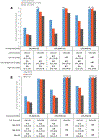Warranty Period of a Calcium Score of Zero: Comprehensive Analysis From MESA
- PMID: 33129734
- PMCID: PMC8076346
- DOI: 10.1016/j.jcmg.2020.06.048
Warranty Period of a Calcium Score of Zero: Comprehensive Analysis From MESA
Abstract
Objectives: This study sought to quantify and model conversion of a normal coronary artery calcium (CAC) scan to an abnormal CAC scan.
Background: Although the absence of CAC is associated with excellent prognosis, progression to CAC >0 confers increased risk. The time interval for repeated scanning remains poorly defined.
Methods: This study included 3,116 participants from the MESA (Multi-Ethnic Study of Atherosclerosis) with baseline CAC = 0 and follow-up scans over 10 years after baseline. Prevalence of incident CAC, defined by thresholds of CAC >0, CAC >10, or CAC >100, was calculated and time to progression was derived from a Weibull parametric survival model. Warranty periods were modeled as a function of sex, race/ethnicity, cardiovascular risk, and desired yield of repeated CAC testing. Further analysis was performed of the proportion of coronary events occurring in participants with baseline CAC = 0 that preceded and followed repeated CAC testing at different time intervals.
Results: Mean participants' age was 58 ± 9 years, with 63% women, and mean 10-year cardiovascular risk of 14%. Prevalence of CAC >0, CAC >10, and CAC >100 was 53%, 36%, and 8%, respectively, at 10 years. Using a 25% testing yield (number needed to scan [NNS] = 4), the estimated warranty period of CAC >0 varied from 3 to 7 years depending on sex and race/ethnicity. Approximately 15% of participants progressed to CAC >10 in 5 to 8 years, whereas 10-year progression to CAC >100 was rare. Presence of diabetes was associated with significantly shorter warranty period, whereas family history and smoking had small effects. A total of 19% of all 10-year coronary events occurred in CAC = 0 prior to performance of a subsequent scan at 3 to 5 years, whereas detection of new CAC >0 preceded 55% of future events and identified individuals at 3-fold higher risk of coronary events.
Conclusions: In a large population of individuals with baseline CAC = 0, study data provide a robust estimation of the CAC = 0 warranty period, considering progression to CAC >0, CAC >10, and CAC >100 and its impact on missed versus detectable 10-year coronary heart disease events. Beyond age, sex, race/ethnicity, diabetes also has a significant impact on the warranty period. The study suggests that evidence-based guidance would be to consider rescanning in 3 to 7 years depending on individual demographics and risk profile.
Keywords: coronary artery calcium; coronary artery disease; risk assessment.
Copyright © 2021 American College of Cardiology Foundation. Published by Elsevier Inc. All rights reserved.
Conflict of interest statement
Funding Support and Author Disclosures This research was supported by contracts HHSN268201500003I, N01-HC-95159, N01-HC-95160, N01-HC-95161, N01-HC-95162, N01-HC-95163, N01-HC-95164, N01-HC-95165, N01-HC-95166, N01-HC-95167, N01-HC-95168 and N01-HC-95169 from the National Heart, Lung, and Blood Institute, and by grants UL1-TR-000040, UL1-TR-001079, and UL1-TR-001420 from the National Center for Advancing Translational Sciences (NCATS). This publication was developed under the Science to Achieve Results (STAR) research assistance agreements, No. RD831697 (MESA Air) and RD-83830001 (MESA Air Next Stage), awarded by the U.S Environmental Protection Agency. It has not been formally reviewed by the EPA. The views expressed in this document are solely those of the authors and the EPA does not endorse any products or commercial services mentioned in this publication. All authors have reported that they have no relationships relevant to the contents of this paper to disclose.
Figures






Comment in
-
Extending the Warranty for Risk-Free Living.JACC Cardiovasc Imaging. 2021 May;14(5):1003-1004. doi: 10.1016/j.jcmg.2021.01.018. Epub 2021 Mar 17. JACC Cardiovasc Imaging. 2021. PMID: 33744137 No abstract available.
References
-
- Mieres JH, Shaw LJ, Arai A et al. Role of noninvasive testing in the clinical evaluation of women with suspected coronary artery disease: Consensus statement from the Cardiac Imaging Committee, Council on Clinical Cardiology, and the Cardiovascular Imaging and Intervention Committee, Council on Cardiovascular Radiology and Intervention, American Heart Association. Circulation 2005;111:682–96. - PubMed
-
- Blaha MJ, Blankstein R, Nasir K. Coronary Artery Calcium Scores of Zero and Establishing the Concept of Negative Risk Factors. J Am Coll Cardiol 2019;74:12–14. - PubMed
Publication types
MeSH terms
Substances
Grants and funding
- HHSN268201500003C/HL/NHLBI NIH HHS/United States
- N01 HC095161/HL/NHLBI NIH HHS/United States
- N01 HC095168/HL/NHLBI NIH HHS/United States
- N01 HC095167/HL/NHLBI NIH HHS/United States
- N01 HC095159/HL/NHLBI NIH HHS/United States
- UL1 TR001420/TR/NCATS NIH HHS/United States
- N01 HC095163/HL/NHLBI NIH HHS/United States
- HHSN268201500003I/HL/NHLBI NIH HHS/United States
- UL1 TR000040/TR/NCATS NIH HHS/United States
- N01 HC095166/HL/NHLBI NIH HHS/United States
- N01 HC095162/HL/NHLBI NIH HHS/United States
- N01 HC095160/HL/NHLBI NIH HHS/United States
- UL1 TR001079/TR/NCATS NIH HHS/United States
- N01 HC095169/HL/NHLBI NIH HHS/United States
- N01 HC095165/HL/NHLBI NIH HHS/United States
- N01 HC095164/HL/NHLBI NIH HHS/United States
LinkOut - more resources
Full Text Sources
Other Literature Sources
Medical

